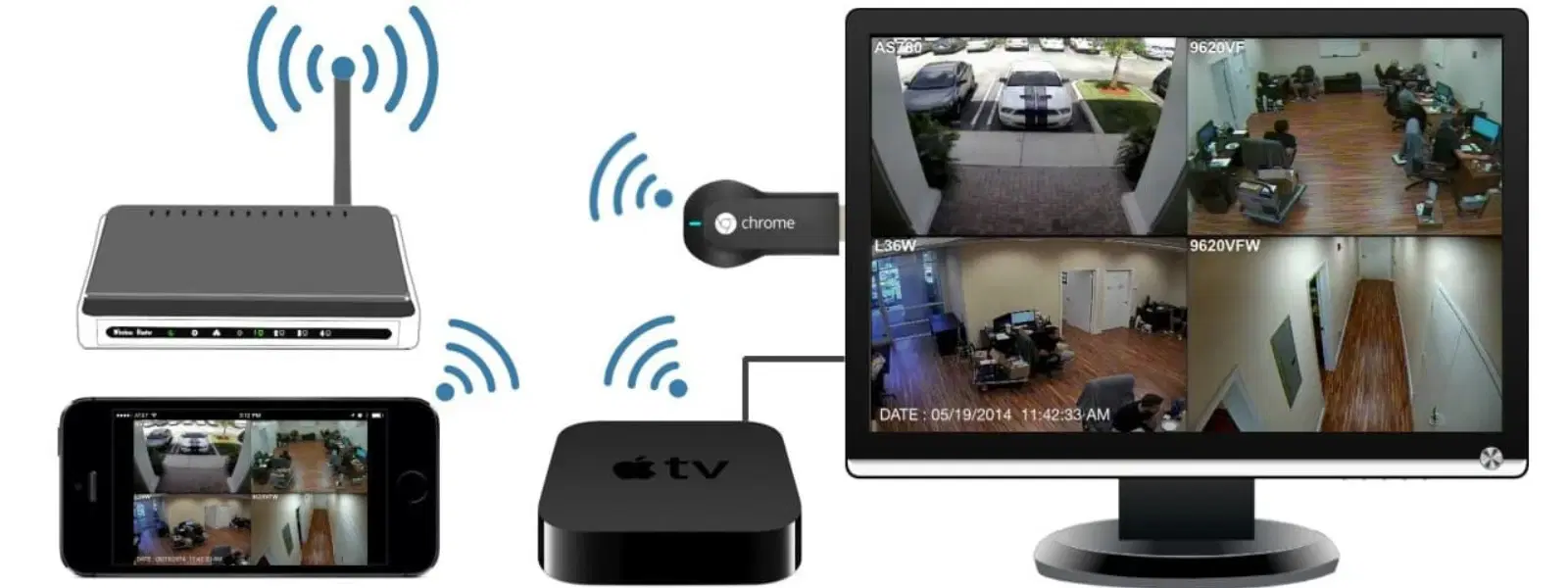
Consumer Electronics
•04 min read
Ever wondered how to seamlessly stream your CCTV footage directly to your TV without the hassle of wires? In today’s fast-paced world, the idea of a wireless CCTV connection is gaining popularity. This guide offers clear answers, step-by-step instructions, and expert tips to help you understand how to connect CCTV to TV wirelessly, ensuring you enjoy a flexible and modern home security setup.
A wireless CCTV connection involves linking your security camera system with your TV without relying on physical cables. This setup often makes use of devices such as a CCTV wireless adapter, a DVR or NVR system, and sometimes smart TVs. By utilising wireless technology, you can stream CCTV footage to TV easily, making it convenient to keep an eye on your property.
A wireless surveillance setup offers several advantages. It provides flexibility in camera placements, reduces the clutter of wires and cables, and simplifies the installation process. Whether you want to connect security camera to TV in a smart home environment or simply stream your security camera feed to a television, the benefits include ease of installation and the freedom to position devices in ideal locations. This method is particularly well-suited for areas with limited wiring options.
Before starting your setup, it is important to gather all the necessary equipment. You will need:
A set of wireless CCTV cameras
A DVR or NVR system to record and manage footage
A reliable CCTV wireless adapter to enable the connection
A smart TV that supports HDMI or other compatible input methods
HDMI cables and, if necessary, AV cables
Also, ensure that your devices are compatible. Many modern TVs, including leading models, support direct inputs for a wireless camera system for TV integration.
When selecting your system, consider factors such as resolution, connectivity range, and compatibility with your existing TV. While many systems can connect DVR to TV wirelessly, it is important to check that your chosen camera system supports the necessary features for your setup. Look for models that allow you to view security camera on TV easily and adjust settings to suit your home environment.
Begin by ensuring all devices are powered up and have a stable connection to your Wi-Fi network. This preliminary step is key to a smooth setup process. Verify that your CCTV cameras, DVR/NVR system, and TV are compatible with one another. It is also a good idea to position your router to maximise wireless coverage across your home.
Follow these steps to connect your CCTV to TV wirelessly:
Step 1: Configure your CCTV camera to connect to your home Wi-Fi. This is the essential first step in a successful wireless surveillance setup.
Step 2: Use a CCTV wireless adapter or your DVR/NVR system to bridge the connection between the camera and your TV.
Step 3: Connect the output from your DVR/NVR to your TV using an HDMI cable, ensuring that the TV is set to the correct input channel.
Step 4: Adjust your TV settings to display the CCTV feed correctly. This may involve configuring the resolution or switching inputs.
If you face challenges like poor video quality or connectivity drops, try repositioning your router or using a signal booster. Ensuring firm distances between devices and avoiding obstructions can often resolve such issues. In some cases, updating the firmware on your devices may improve performance.
Pro Tip: Maximise Your Wireless CCTV Setup
Did you know that using a dual-band Wi-Fi router can significantly improve the stability of your wireless CCTV connection? Opt for a router that supports both 2.4GHz and 5GHz frequencies to reduce interference and ensure smoother video streaming.
Integrating your surveillance system into a smart home is easier than ever. Many smart TVs can directly receive feeds from CCTV cameras via dedicated apps. This integration extends beyond just viewing; it allows for remote control and monitoring, providing a comprehensive home security solution.
If you wish to monitor several areas of your home simultaneously, consider using a video multiplexer or configuring your DVR to display multiple feeds. This means you can easily stream CCTV footage to TV from various camera angles, offering a more complete overview of your property.
Connect your CCTV camera to a DVR or NVR system, then link the DVR/NVR to your TV using HDMI or wirelessly via a compatible adapter.
Yes, most modern TVs can act as monitors for CCTV cameras by connecting via HDMI, AV cables, or wireless adapters.
Yes, some wireless cameras can connect directly to smart TVs using apps or wireless adapters. However, DVRs or NVRs are recommended for enhanced functionality and reliability.
For a direct connection, use an AV cable, HDMI cable, or wireless adapter, depending on the compatibility of your camera and TV.
The best method involves using a wireless CCTV camera system paired with a DVR/NVR that supports Wi-Fi and HDMI output. This combination ensures a dependable CCTV TV integration for clear and uninterrupted footage.
This guide demonstrates that connecting CCTV to TV wirelessly is not as complex as it might seem. With thoughtful planning, the right tools, and our easy-to-follow steps, you can enjoy a neat, organised home security solution. The benefits of such a setup are clear: reduced clutter, versatile camera placement, and the convenience of monitoring your home with ease. Tata Neu stands by as a platform that provides you with expert guidance and even rewards in the form of NeuCoins on your purchases, offering a seamless experience that supports your lifestyle progression.
Through this exploration, it is evident that a wireless CCTV system offers flexibility and high performance for tech enthusiasts, families, young professionals, and students alike. Understanding the tools and the process can empower you to upgrade your home security smartly and efficiently.